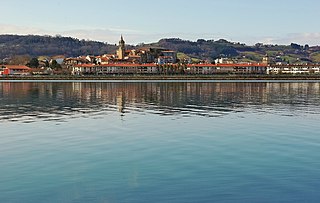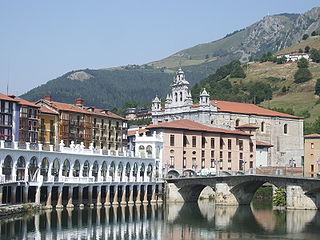
Hondarribia is a town situated on the west shore of Bidasoa river's mouth, in Gipuzkoa, in the Basque Autonomous Community.

Eibar is a city and municipality within the province of Gipuzkoa, in the Autonomous Community of Euskadi. It is the capital of the eskualde / comarca of Debabarrena.

Gipuzkoa is a province of Spain and a historical territory of the autonomous community of the Basque Country. Its capital city is Donostia-San Sebastián. Gipuzkoa shares borders with the French department of Pyrénées-Atlantiques at the northeast, with the province and autonomous community of Navarre at east, Biscay at west, Álava at southwest and the Bay of Biscay to its north. It is located at the easternmost extreme of the Cantabric Sea, in the Bay of Biscay. It has 66 kilometres of coast land.

Tolosa is a town and municipality in the Basque province of Gipuzkoa, in northern Spain. It is located in the valley of the river Oria, next by Uzturre, a local mountain topped by a white cross.

Alkiza is a rural municipality in the centre of Gipuzkoa, northwest of the Tolosaldea County, in the Basque Country. It is 27 kilometres south of San Sebastian. In 2019 it had 373 inhabitants, of which 88.8% were Basque speakers. Alkiza is an independent municipality since 1731; previously it depended on Tolosa and San Sebastian.

Leintz Gatzaga is a town located in the province of Gipuzkoa, in the Autonomous Community of Basque Country, northern Spain. The municipality's population is 251 (2015).

Oiartzun is a town and municipality located in the Basque Country, in the province of Gipuzkoa lying at the foot of the massif Aiako Harria.

Orio is a fishing town located in the province of Gipuzkoa in the Basque Autonomous Community, northern Spain, with the town nucleus lying on the river Oria, roughly one mile away from its mouth by the Bay of Biscay. Orio had a population of 5,901 inhabitants as of 2016.

Usurbil is a town and region located in the province of Gipuzkoa in the Autonomous Community of the Basque Country, in the North of Spain.

Elorrio is a town and a municipality located in the eastern part of the province of Biscay, in the Basque Country, in northern Spain. As of 2017, it has a population of 7,307 inhabitants. It covers an area of 37.20 square kilometers and it has a population density of 193.58 people per square kilometer. It holds the medieval title of Most Loyal and Noble Villa.

Getxo is a town located in the province of Biscay, in the autonomous community of the Basque Country, in Spain. It is part of Greater Bilbao, and has 75,430 inhabitants (2023). Getxo is mostly an affluent residential area, as well as being the third largest municipality of Biscay.

Loiu is a town and municipality located in the province of Biscay, in the autonomous community of Basque Country, northern Spain.

Agurain in Basque or Salvatierra in Spanish, officially Agurain/Salvatierra, is a town and municipality located in the province of Álava in the Basque Autonomous Community, northern Spain. The municipality has a population of 5,155 inhabitants as of 2024 and is the most populous town in the cuadrilla of Llanada Alavesa.

Banca is a commune of the Pyrénées-Atlantiques department in the Nouvelle-Aquitaine region of south-western France. It is part of the former province of Lower Navarre.

Hernani is a town and municipality located in the province of Gipuzkoa, Basque Autonomous Community, Spain. The town sits on the left bank of the Urumea river. It is located at a distance of 9.2 km from San Sebastián. The municipality of Hernani occupies an area of approximately 40 square kilometres and is bordered by San Sebastián, Astigarraga, Arano, Elduayen, Errenteria, Lasarte-Oria and Urnieta.

San Sebastián, officially known by the bilingual name Donostia / San Sebastián, is a city and municipality located in the Basque Autonomous Community, Spain. It lies on the coast of the Bay of Biscay, 20 km from the France–Spain border. The capital city of the province of Gipuzkoa, the municipality's population is 188,102 as of 2021, with its metropolitan area reaching 436,500 in 2010. Locals call themselves donostiarra (singular), both in Basque and Spanish. It is also a part of Basque Eurocity Bayonne-San Sebastián.

The Agorregi Forge is located within the Pagoeta Nature Reserve, near the town of Aia, in the Basque Province of Gipuzkoa, Spain. It is one of the best preserved examples of a foundry in Gipuzkoa province. The forge which can be seen today is a built in 1754 by the lord of Laurgain Palace over the ruins of an earlier version. Lying at the bottom of a deep valley near Manterola farmhouse, it used the river's hydraulic energy to power its great bellows and turn its waterwheels.

Pagoeta Natural Park is a park in Gipuzkoa, Basque Autonomous Community, Spain. Mount Pagoeta is closest to the villages of Aia and Laurgain, and near the coastal towns of Zarautz and Orio. The park features a park house, a museum, and picnic areas. Group guided tours are available.

Debabarrena is an eskualdea / comarca located in Gipuzkoa, Basque Country (Spain). It has an area of 180,3 km2. It is north from the comarca of Debagoiena, east from the province of Biscay, and south from the Gulf of Biscay.

The autonomous community of the Basque Country within Spain contains several comarcas or eskualdeak in the Basque language, referring to local districts, grouped into its three long-established provinces.

























